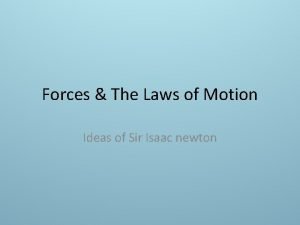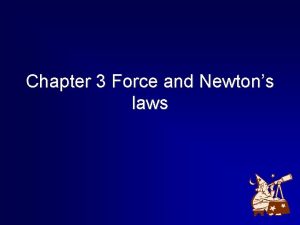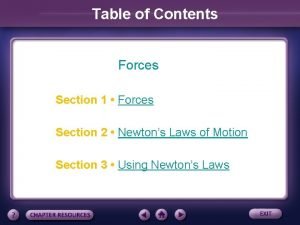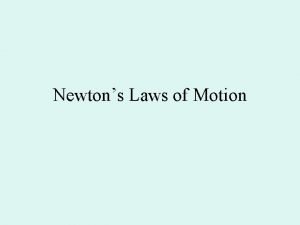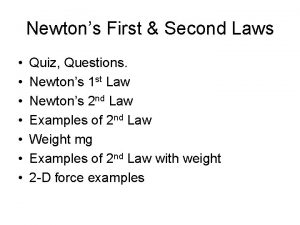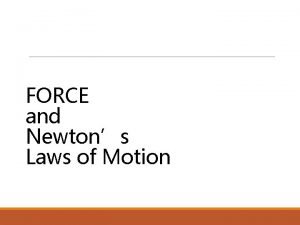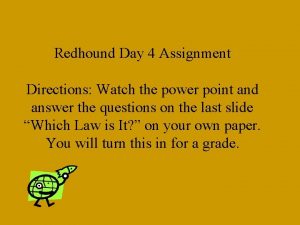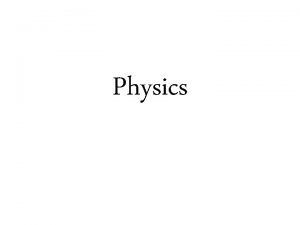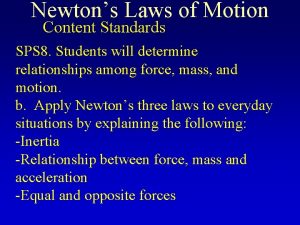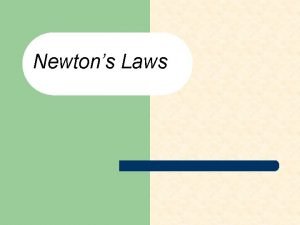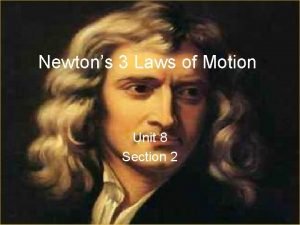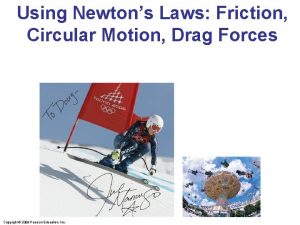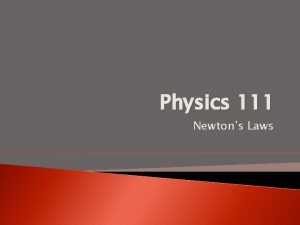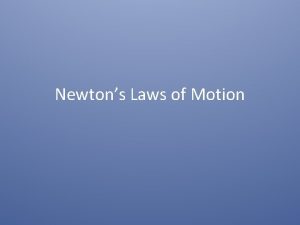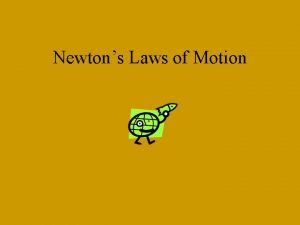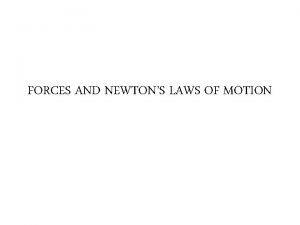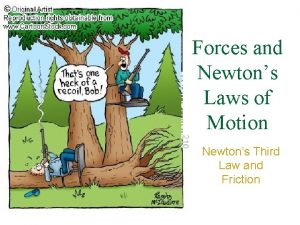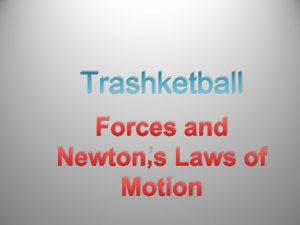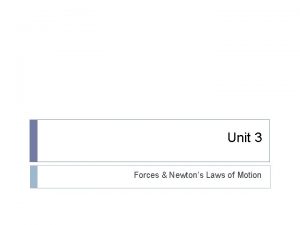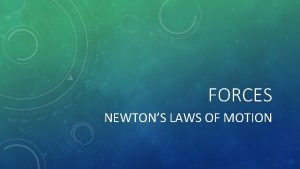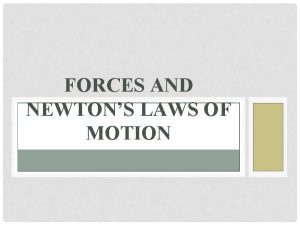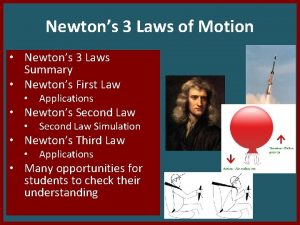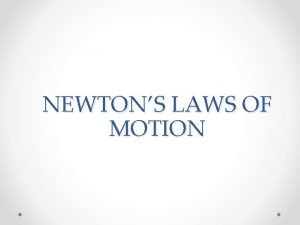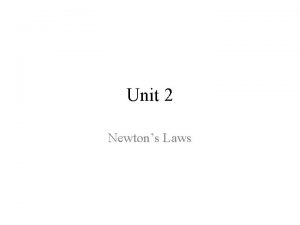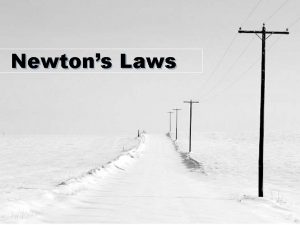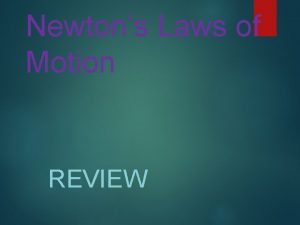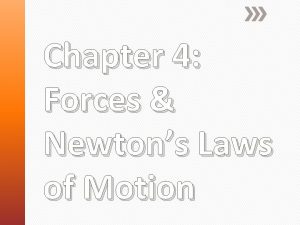Newtons Laws Forces and Motion Laws of Motion
























- Slides: 24

Newton’s Laws Forces and Motion

Laws of Motion formulated by Issac Newton in the late 17 th century n written as a way to relate force and motion n Newton used them to describe his observations of planetary motion. n

History n n n Aristotle was an ancient Greek philosopher Based on his observations the common belief was that in order for an object to continue moving, a force must be exerted in the direction of the motion This lasted until Issac Newton proposed his “Laws of Motion” based on observations made of bodies free from earth’s atmosphere.

Newton’s 1 st Law Inertia An object at rest will stay at rest, and an object in motion will stay in motion at constant velocity unless acted on by an unbalanced force. This statement contradicted Aristotle’s teaching and was considered a radical idea at the time. However, Newton proposed that there was, in fact, an unrecognized force of resistance between objects that was causing them to stop in the absence of an applied force to keep them moving. This new unseen resistance force became known as “friction”.

Newton’s 2 nd Law Fnet = ma If an unbalanced force acts on a mass, that mass will accelerate in the direction of the force. 2 N 8 N a Since 8 N is greater than 2 N, the unbalanced force (6 N) is to the right so the acceleration is to the right. Newton’s 1 st Law says that without an unbalanced force objects will remain at constant velocity (a=0)…so it seems logical to say that if we apply a force we will see an acceleration.

Newton’s 3 rd Law Action - Reaction For every action force there is an equal and opposite reaction force. Example: If you punch a wall with your fist in anger, the wall hits your fist with the same force. That’s why it hurts! Action-reaction forces cannot balance each other out because they are acting on different objects. The forces acting on an object determine their motion.

or n n Acceleration and net force are directly related. If Fnet doubles, acceleration doubles. Acceleration and mass are indirectly related. If m doubles, acceleration is half as much.

A Force is… Measured in Newtons (N) in the metric (SI) system and pounds (lbs) in the English system n A vector quantity requiring magnitude and direction to describe it n Represented by drawing arrows on a diagram n

Types of Forces (that we will study now – there are many more) n n n n Weight - force of gravity Normal force – surface pushing back Friction - resistance force that opposes motion Applied force - force you exert, push or pull Tension - applied through a rope or chain Net force – total vector sum of all forces Balanced forces – equal and opposite forces Unbalanced forces – not equal and opposite

Weight The force of gravity acting on a mass. Weight always acts down! Weight = mass (kg) * acceleration due to gravity Weight is a force…so this is a special case of F=ma and the unit is a Newton.

Mass is… The amount of matter in an object. n Measured in kilograms. n NOT a force. n The same at any location, even on another planet. Not influenced by gravity. n

Normal Force (FN) n n Defined as the force of a surface pushing back on an object. Always directed perpendicular to the surface. This is a contact force. No contact…no normal force. NOT always equal to weight. Examples: FN FN Table W a l l

Friction n n n A resistance force usually caused by two surfaces moving past each other. Always in a direction that opposes the motion. Measured in Newtons. Depends on surface texture and how hard the surfaces are pressed together. Surface texture determines the coefficient of friction (μ) which has no units. Normal force measures how hard the surfaces are pressed together.

Types of friction n n Static friction is the force an object must overcome to start moving. Kinetic friction is the force an object must overcome to keep moving. Static friction is always greater than kinetic friction!

Calculating the Force of Friction Where f is the force of friction, μ is the coefficient of friction, and FN is the normal force. μ has no units! For kinetic friction: For static friction:

May the n n Net Force be with you Total force acting on an object Vector sum of all the forces The unbalanced force referred to in Newton’s Law of Motion Net force is equal to the mass of an object times the acceleration of that object.

Net force can be found by finding the sum of the force vectors or by mass times acceleration. Example using mass times acceleration: Find the net force for a 20 kg object that is being accelerated at 3 m/s 2.

If acceleration is not given, use the kinematics equations to find “a” first:

Or conversely you may have to use the Fnet formula to get acceleration and then the kinematics equations to find t, d, vi, or vf.

Finding net force using sum of the force vectors: Example 2 Example 1 10 N 50 N 30 N Fnet =10 N Fnet= 20 N 40 N Example 3 15 N 5 N 7 N 14 N 12 N 2 N Must draw vectors tip to tail first before solving: Fnet = 7 N 6 N Fnet 2 = 14 2 + 7 Fnet = 15. 7 N 2 Ө = tan-1 (14 / 7) Ө = 63. 4º Ө 7 N 14 N

Force Diagrams n n n Force diagrams must include the object and all forces acting on it. The forces must be attached to the object. No other vectors may be attached to the object. Components of forces, axis systems, motion vectors and other objects or surfaces may be included in force diagrams. Put the mass in the object box.

Force Diagram Problem: A 10 kg crate with an applied force of 100 N slides across a warehouse floor where the coefficient of static friction is 0. 3 between the crate and the floor. What is the acceleration of the crate? FN f = μFN 10 kg Fapplied = 100 N Weight = Fg = (10 kg)*(9. 8 m/s 2)

To Solve the Problem Now that you have the force diagram! Problem: A 10 kg crate with an applied force of 100 N slides across a warehouse floor where the coefficient of static friction is 0. 3 between the crate and the floor. What is the acceleration of the crate. FN f = μFN 10 kg Fapplied = 100 N a Weight = Fg = (10 kg)*(9. 8 m/s 2) Write the Newton’s 2 nd Law equation for the x- and y- directions. This time we will use both sum of forces and ma as Fnet. Now plug in what you know and solve for what you don’t.

Solving the Problem: A 10 kg crate with an applied force of 100 N slides across a warehouse floor where the coefficient of static friction is 0. 3 between the crate and the floor. What is the acceleration of the crate. FN f = μFN 10 kg Weight = Fg = (10 kg)*(9. 8 m/s 2) Fapplied = 100 N a
 Newtons laws od motion
Newtons laws od motion Newtons second lw
Newtons second lw Law of newton 3
Law of newton 3 3 law of newton
3 law of newton Derek leaves his physics book on top of a drafting table
Derek leaves his physics book on top of a drafting table Newtons laws
Newtons laws 6 67 x 10^-11
6 67 x 10^-11 Newton's 3 laws
Newton's 3 laws Third law of newton
Third law of newton Section 3 using newtons law
Section 3 using newtons law Section 1 forces
Section 1 forces Abcd8n
Abcd8n First law of motion facts
First law of motion facts Newtons law quiz
Newtons law quiz Newtons laws definitions
Newtons laws definitions Newton's 3 laws
Newton's 3 laws Newton's all law
Newton's all law Newtons laws
Newtons laws Newton's law
Newton's law Second law of motion examples
Second law of motion examples Newton's 3 law of motion
Newton's 3 law of motion Newton's first law of motion examples
Newton's first law of motion examples Newtons laws
Newtons laws It's friday night and skyler has been assigned
It's friday night and skyler has been assigned Newtons 3 rd law of motion
Newtons 3 rd law of motion




